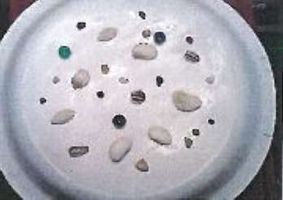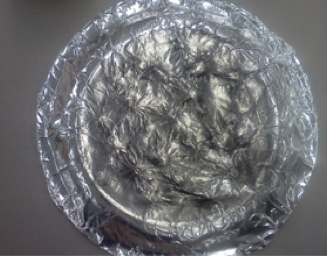Students will use contrasting textures and various materials to create a night scene featuring shooting stars and a textured moon. Recommended for 1st Graders.
Texture: Actual texture is how something feels when touched; visual texture (also called simulated texture) is how something appears to feel.
Contrast: The difference between elements of art in the composition. In this lesson there is contrast between the rough & smooth surfaces of the artwork.
Prepare examples of real texture using familiar small items from nature or everyday life. Keep them examples a flat box to be passed around.
Prepare quick slide show of images, both in photographs & art that show textured subjects in nature or everyday life.
- Write the word ‘texture’ on the whiteboard and ask students to repeat it. Use this word often during the lesson.
- Talk about words that might be used to describe different types of textures: fuzzy, soft, hard, etc.
- Discuss how different textures might feel: bumpy, wet, prickly, etc.
Students will:



Adapted from the “Metallic Moon” lesson from the 2011 ISF Arts Integration grant.
21st Century Thinking Skills
Thinking Flexibly, Persisting, Creating, Taking Responsible Risks, Reflecting, Observing, Making Connections, Visualizing, Comparing/Contrasting, Finding Evidence, Cause and Effect, Decision Making, Evaluating.
WA State Learning Standards
(VA:Cr1.1.1) a. Engage collaboratively in exploration and imaginative play with materials. This happens when they explore different textures.
(VA:Cr1.2.1) a. Use observation and investigation in preparation for making a work of art.This happens when they watch the presentation of the lesson.
(VA:Cr2.1.1) a. Explore uses of materials and tools to create works of art or design.This happens when using scissors, paper, glue, glitter, foil & textured objects.
(VA:Cr2.2.1) a. Demonstrate safe and proper procedures for using materials, tools, and equipment while making art.
(VA:Cr3.1.1) a. Use art vocabulary to describe choices while creating art. This happens when you explain ‘texture’ & ‘contrast’.
(VA:Re8.1.1) a. Interpret art by categorizing subject matter and identifying the characteristics of form. This happens when contrasting subject matters’ textures.
Arts Integration Opportunities
Writing: procedural (how we did it), informative (what texture is, what contrast is), spelling words, descriptive (which parts have which textures).
Please note: These lesson plans are intended for non-profit use only. Use of these plans for commercial purposes should give attribution to the Issaquah Schools Foundation and be accompanied by a nominal donation at www.isfdn.org/donate. Thank you.
Fueling Success for Every Student, Every School